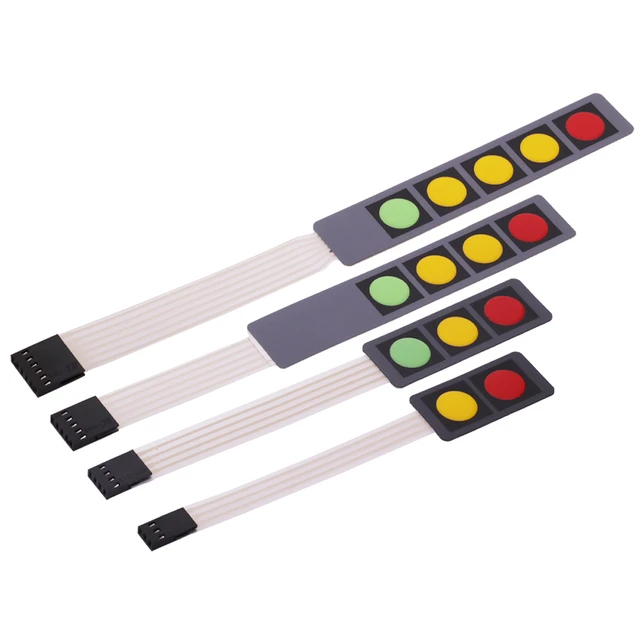Recognizing Membrane Switches Over: The Secret to Durable and Trusted Controls

What Are Membrane Switches?
Membrane switches are a sophisticated service in the realm of interface innovation, integrating functionality and style perfectly. These gadgets work as a user interface between individuals and electronic systems, integrating numerous parts into a small layout. Generally created from flexible, thin layers of materials, membrane buttons are made to reply to touch, allowing users to interact with machinery and digital gadgets efficiently.
The main components of a membrane switch include a published circuit layer, graphic overlay, and a spacer layer that avoids unintentional activation. The visuals overlay can be personalized to mirror brand identity or individual preferences, enhancing looks while making certain use. Membrane switches are commonly utilized in various applications, including clinical devices, customer electronics, and industrial tools, owing to their durability and resistance to environmental elements such as moisture and dirt.
Among the key benefits of membrane buttons is their capacity to hold up against wear and tear, making them optimal for high-traffic atmospheres. Furthermore, they are light-weight and need marginal area, permitting cutting-edge designs in product growth. On the whole, membrane switches stand for a reliable and useful option for modern digital user interfaces, weding modern technology with user-centric design principles.
How Membrane Layer Switches Job
The procedure of membrane switches hinges on a simple yet reliable mechanism that equates individual input into electronic signals. When a user presses the switch, the leading layer deforms, allowing a conductive element in the circuit layer to make contact with a corresponding conductive pad on the bottom of the graphic overlay.
The design of membrane switches can differ, but they typically integrate domes or tactile elements to give responses to the customer, boosting the total experience - membrane switch. The products utilized in membrane layer buttons, such as polyester or polycarbonate, add to their toughness and resistance to ecological aspects, consisting of moisture and dirt. The published circuits are generally enveloped, which safeguards them from wear and tear over time.
Advantages of Membrane Layer Buttons

Furthermore, membrane buttons are understood for their sturdiness. Built from robust products, they are immune to dirt, dampness, and physical wear, which substantially prolongs their life expectancy compared to conventional mechanical buttons. This toughness makes them particularly appropriate for high-traffic environments and applications calling my website for long life.
Another substantial benefit is the ease of cleaning and maintenance. The smooth surface of membrane layer switches reduces dust build-up and is frequently unsusceptible spills, making them ideal for settings that require regular sanitization.
Additionally, membrane buttons this post supply a streamlined account, resulting in a thinner layout that can be incorporated right into various tools without including mass. This feature not just improves the visual charm however additionally adds to an extra ergonomic product layout.
Applications of Membrane Layer Switches
Versatile and straightforward, membrane buttons find applications across a variety of sectors, consisting of clinical devices, consumer electronics, and commercial devices. In the clinical area, these switches are indispensable to devices such as analysis equipment, individual tracking systems, and mixture pumps, where integrity and convenience of cleaning are vital. Their capability to keep and stand up to extreme atmospheres functionality makes them perfect for such applications.

In consumer electronics, membrane layer switches are used in products like microwaves, cleaning machines, and push-button controls - membrane switch. Their smooth style enables user-friendly customer interfaces, improving the general individual experience while giving longevity and resistance to tear and put on
Industrial tools also takes advantage of membrane layer buttons, especially in control panels for machinery and automation systems. These buttons use security against dust and moisture, ensuring constant efficiency in difficult settings. Their personalized functions enable manufacturers to customize them to particular functional needs, enhancing effectiveness and capability.
Selecting the Right Membrane Layer Switch
When picking a membrane button, it is vital to think about different aspects that influence efficiency and suitability for particular applications. The primary considerations consist of environmental conditions, tactile comments, toughness, and layout requirements.
First, evaluate the operating environment; switches subjected to wetness, chemicals, or extreme temperature levels need particular materials to make sure longevity and performance. Next, review the demand for tactile responses. Depending upon customer interaction, some applications might gain from a responsive response to validate activation, while others may like a non-tactile layout for aesthetic reasons.
Longevity is one more essential element; membrane layer buttons need to be made to stand up to constant use, impacts, and abrasion. Ensure the chosen button can endure the anticipated lifecycle, especially in high-usage scenarios.

Conclusion
In final thought, membrane layer changes offer as necessary components in the layout of long lasting and reliable control systems throughout various sectors. The flexibility of membrane layer switches over permits for tailored options that meet particular functional needs, strengthening their importance in modern technology.
Membrane layer switches over represent an essential facet of modern-day interface layout, mixing performance with durability in different applications.Membrane layer buttons are an innovative solution in the realm of user interface innovation, integrating performance and style flawlessly. Typically constructed from flexible, thin layers of materials, membrane switches are designed to respond to touch, enabling users to interact with more information machinery and digital tools properly.
The layout of membrane layer buttons can differ, but they usually incorporate domes or tactile elements to give responses to the user, improving the total experience.In final thought, membrane switches serve as vital parts in the style of dependable and long lasting control systems throughout numerous industries.